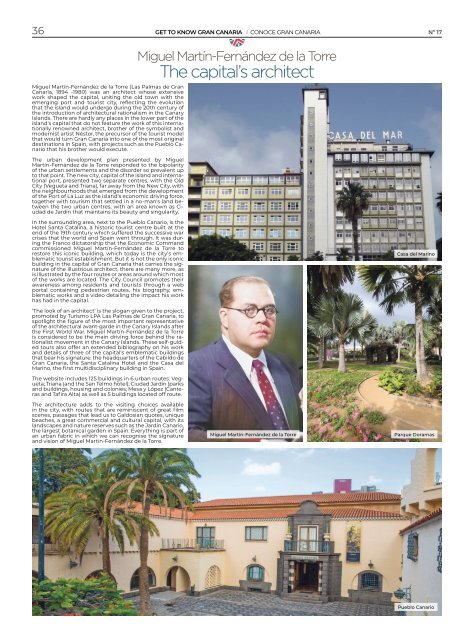No. 17 - Its Gran Canaria Magazine
Rutas, recomendaciones y noticias de Gran Canaria. Routes, tips and news about Gran Canaria.
Rutas, recomendaciones y noticias de Gran Canaria.
Routes, tips and news about Gran Canaria.
Create successful ePaper yourself
Turn your PDF publications into a flip-book with our unique Google optimized e-Paper software.
36<br />
GET TO KNOW GRAN CANARIA I CONOCE GRAN CANARIA Nº <strong>17</strong><br />
Miguel Martín-Fernández de la Torre (Las Palmas de <strong>Gran</strong><br />
<strong>Canaria</strong>, 1894 -1980) was an architect whose extensive<br />
work shaped the capital, uniting the old town with the<br />
emerging port and tourist city, reflecting the evolution<br />
that the island would undergo during the 20th century of<br />
the introduction of architectural rationalism in the Canary<br />
Islands. There are hardly any places in the lower part of the<br />
island's capital that do not feature the work of this internationally<br />
renowned architect, brother of the symbolist and<br />
modernist artist Néstor, the precursor of the tourist model<br />
that would turn <strong>Gran</strong> <strong>Canaria</strong> into one of the most original<br />
destinations in Spain, with projects such as the Pueblo Canario<br />
that his brother would execute.<br />
The urban development plan presented by Miguel<br />
Martín-Fernández de la Torre responded to the bipolarity<br />
of the urban settlements and the disorder so prevalent up<br />
to that point. The new city, capital of the island and international<br />
port, presented two separate centres, with the Old<br />
City (Vegueta and Triana), far away from the New City, with<br />
the neighbourhoods that emerged from the development<br />
of the Port of La Luz as the island's economic driving force,<br />
together with tourism that settled in a no-man's land between<br />
the two urban centres, with an area known as Ciudad<br />
de Jardín that maintains its beauty and singularity.<br />
Miguel Martín-Fernández de la Torre<br />
The capital’s architect<br />
In the surrounding area, next to the Pueblo Canario, is the<br />
Hotel Santa Catalina, a historic tourist centre built at the<br />
end of the 19th century which suffered the successive war<br />
crises that the world and Spain went through. It was during<br />
the Franco dictatorship that the Economic Command<br />
commissioned Miguel Martín-Fernández de la Torre to<br />
restore this iconic building, which today is the city's emblematic<br />
tourist establishment. But it is not the only iconic<br />
building in the capital of <strong>Gran</strong> <strong>Canaria</strong> that carries the signature<br />
of the illustrious architect, there are many more, as<br />
is illustrated by the four routes or areas around which most<br />
of the works are located. The City Council promotes their<br />
awareness among residents and tourists through a web<br />
portal containing pedestrian routes, his biography, emblematic<br />
works and a video detailing the impact his work<br />
has had in the capital.<br />
Casa del Marino<br />
‘The look of an architect’ is the slogan given to the project,<br />
promoted by Turismo LPA Las Palmas de <strong>Gran</strong> <strong>Canaria</strong>, to<br />
spotlight the figure of the most important representative<br />
of the architectural avant-garde in the Canary Islands after<br />
the First World War. Miguel Martín-Fernández de la Torre<br />
is considered to be the main driving force behind the rationalist<br />
movement in the Canary Islands. These self-guided<br />
tours also offer an extended bibliography on his work<br />
and details of three of the capital's emblematic buildings<br />
that bear his signature: the headquarters of the Cabildo de<br />
<strong>Gran</strong> <strong>Canaria</strong>, the Santa Catalina Hotel and the Casa del<br />
Marino, the first multidisciplinary building in Spain.<br />
The website includes 125 buildings in 6 urban routes: Vegueta;<br />
Triana (and the San Telmo hotel); Ciudad Jardín (parks<br />
and buildings, housing and colonies; Mesa y López (Canteras<br />
and Tafira Alta) as well as 5 buildings located off route.<br />
The architecture adds to the visiting choices available<br />
in the city, with routes that are reminiscent of great film<br />
scenes, passages that lead us to Galdosian quotes, unique<br />
beaches, a great commercial and cultural capital, with its<br />
landscapes and nature reserves such as the Jardín Canario,<br />
the largest botanical garden in Spain. Everything is part of<br />
an urban fabric in which we can recognise the signature<br />
and vision of Miguel Martín-Fernández de la Torre.<br />
Miguel Martín-Fernández de la Torre<br />
Parque Doramas<br />
Pueblo Canario

















